Albert Paley records Otocast audio for his Riviera-St. Tropez sculpture, ‘Naiad’
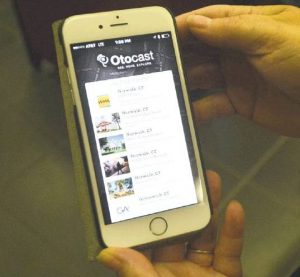 The City of Fort Myers is about to launch a free phone app that will enable users to learn about all the public artworks that are interspersed throughout the town. Called Otocast, the app contains text and historic photos for each covered artwork. But the app’s centerpiece is an audio recording made by the artist who created the piece or someone who is intimately familiar with the artwork and the stories it recounts. By virtue of this audio component, Otocast is like having your very own tour
The City of Fort Myers is about to launch a free phone app that will enable users to learn about all the public artworks that are interspersed throughout the town. Called Otocast, the app contains text and historic photos for each covered artwork. But the app’s centerpiece is an audio recording made by the artist who created the piece or someone who is intimately familiar with the artwork and the stories it recounts. By virtue of this audio component, Otocast is like having your very own tour 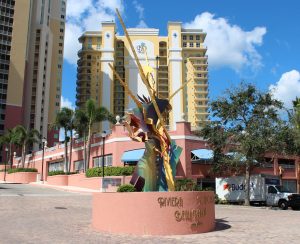 guide who knows the coolest facts and behind-the-scenes stories about the art pieces you see all around you.
guide who knows the coolest facts and behind-the-scenes stories about the art pieces you see all around you.
One of those artworks is Naiad by Rochester, New York sculptor Albert Paley. It’s located off Palm Beach Boulevard in the entrance to the Riviera-St. Tropez condominium complex. Although the multi-colored polychrome steel modernist piece is not technically owned by the City of Fort Myers, it was commissioned 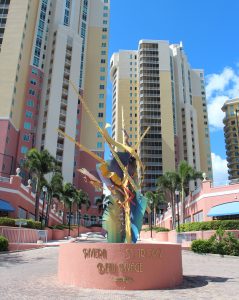 and installed by the developer in accordance with the City’s public art ordinance.
and installed by the developer in accordance with the City’s public art ordinance.
Paley is a phenom in the world of public art, so having an example of his work in downtown Fort Myers is quite a coup. Over the past four decades, he has created monumental site-specific metal assemblages that place him not only in the forefront of contemporary sculpture, but in the vanguard of artists working in the cutting-edge genre-defying field of “Archisculpture.” In fact, the American Institute of Architects took note of Paley’s work in the Archisculpture several years ago, naming him the first metal sculptor to ever receive its coveted Institute Honors 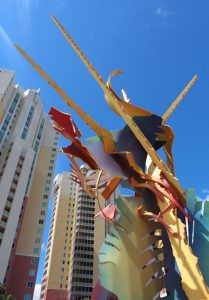 Award, the highest award conferred by AIA on a non-architect. As one noted architect has stated, “The allure of Paley’s art comes through its intrinsic sense of integration of art and architecture.”
Award, the highest award conferred by AIA on a non-architect. As one noted architect has stated, “The allure of Paley’s art comes through its intrinsic sense of integration of art and architecture.”
Paley continually pushes the boundaries of his work, its process and materials through several contexts, questioning old categories and redefining himself through his own distinctive idiom, which is at once visionary and persuasively tangible. Forging steel in a form of plasticity and pliability, Paley addresses the transformational change of the material through tapering, swaging, splitting, upsetting and punching. The result is sculpture developed of organic form analogous to processes 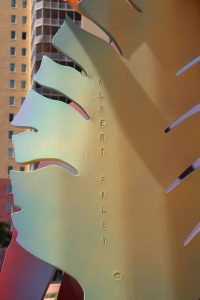 seen in nature, such as the development of organic form in response to gravity with the emphasis on transition through the quality of line, and his use of steel has been described as industrial poetry. The process enables Paley to go beyond creating sculptures that stand as isolated works of art. Instead, his sculptures enhance the spaces in which they are placed and, in return, are enhanced by those spaces.
seen in nature, such as the development of organic form in response to gravity with the emphasis on transition through the quality of line, and his use of steel has been described as industrial poetry. The process enables Paley to go beyond creating sculptures that stand as isolated works of art. Instead, his sculptures enhance the spaces in which they are placed and, in return, are enhanced by those spaces.
Interestingly, the artist got his start in the mid-1960s as a goldsmith. Within a decade he became involved with the forging of steel. He is a long-standing leader in the metal sculpture arena, where he is widely recognized for evolving blacksmithing into the realm of public art and commissions.
 Commissioned by both public institutions and private corporations, Paley has completed more than 60 site-specific works. Some notable examples are the Portal Gates for the Renwick Gallery of the Smithsonian Institution in Washington D.C., Synergy, a ceremonial archway in Philadelphia, the Portal Gates for the New York State Senate Chambers in Albany, Sentinel, a monumental plaza sculpture for Rochester Institute of Technology, as well as a 65-foot sculpture for the entry court of Bausch and Lomb’s headquarters in Rochester, N.Y. Recently completed works include three sculptures for the National Harbor development near Washington D.C., a 130’ long archway named Animals Always
Commissioned by both public institutions and private corporations, Paley has completed more than 60 site-specific works. Some notable examples are the Portal Gates for the Renwick Gallery of the Smithsonian Institution in Washington D.C., Synergy, a ceremonial archway in Philadelphia, the Portal Gates for the New York State Senate Chambers in Albany, Sentinel, a monumental plaza sculpture for Rochester Institute of Technology, as well as a 65-foot sculpture for the entry court of Bausch and Lomb’s headquarters in Rochester, N.Y. Recently completed works include three sculptures for the National Harbor development near Washington D.C., a 130’ long archway named Animals Always 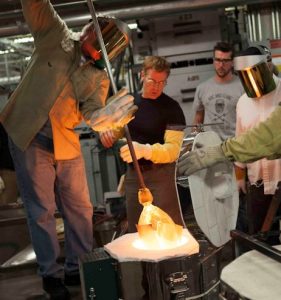 for the St. Louis Zoo, a gate for the Cleveland Botanical Gardens in Cleveland, Ohio, a sculptural relief for Wellington Place, Toronto, Canada, a sculpture named Threshold for the Corporate Headquarters of Klein Steel, Rochester, N.Y., and a ceremonial entranceway called Transformation for Iowa State University in Ames, Iowa.
for the St. Louis Zoo, a gate for the Cleveland Botanical Gardens in Cleveland, Ohio, a sculptural relief for Wellington Place, Toronto, Canada, a sculpture named Threshold for the Corporate Headquarters of Klein Steel, Rochester, N.Y., and a ceremonial entranceway called Transformation for Iowa State University in Ames, Iowa.
Pieces by Albert Paley can be found in the permanent collections of many major museums including the Metropolitan Museum of Art in New York, the Museum of 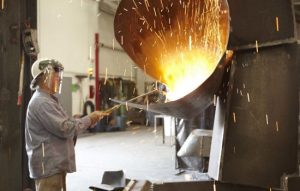 Fine Arts in Boston, the Museum of Fine Arts in Houston, and the Victoria and Albert Museum in London.
Fine Arts in Boston, the Museum of Fine Arts in Houston, and the Victoria and Albert Museum in London.
Southwest Florida is also the site of three other Paley works. His sculpture, Cross Currents, stands at the east entrance to Florida Gulf Coast University’s interior courtyard between Howard and McTarnaghan Halls. At 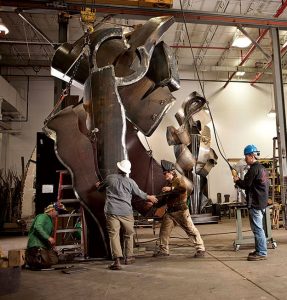 the gray marble entry to the Patty & Jay Baker Naples Museum of Art stand The Paley Gates, an exceptional example of the unique portals, passageways and thresholds long associated with the art of Albert Paley. Paley also created ornate handles for the lobby doors of the Philharmonic Center for the Arts. Known for his inventive and novel approach to both metalsmithing and jewelry design, Paley cut the Phil’s door handles in the form of a bronze ribbon that both commemorates events at the Center and suggests an experience in time.
the gray marble entry to the Patty & Jay Baker Naples Museum of Art stand The Paley Gates, an exceptional example of the unique portals, passageways and thresholds long associated with the art of Albert Paley. Paley also created ornate handles for the lobby doors of the Philharmonic Center for the Arts. Known for his inventive and novel approach to both metalsmithing and jewelry design, Paley cut the Phil’s door handles in the form of a bronze ribbon that both commemorates events at the Center and suggests an experience in time. 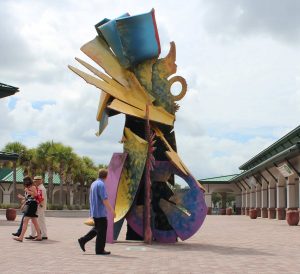 A fallen piece of ribbon or banner is a recurring theme in the sculptures Paley crafts to serve as rites of passages for visitors entering a building.
A fallen piece of ribbon or banner is a recurring theme in the sculptures Paley crafts to serve as rites of passages for visitors entering a building.
Broadly published and an international lecturer, Paley received both his BFA and MFA from the Tyler School of Art in Philadelphia. He received honorary doctorates from the University of Rochester in 1989, the State University of New York at Brockport in 1996, St. Lawrence University, in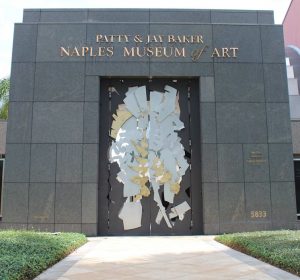 Canton, New York in 1997 and the University of Gothenburg in Sweden in 2012. He also holds an endowed chair at the Rochester Institute of Technology.
Canton, New York in 1997 and the University of Gothenburg in Sweden in 2012. He also holds an endowed chair at the Rochester Institute of Technology.
A Distinguished Professor, Paley holds an Endowed Chair at the College of Imaging Arts and Sciences at Rochester Institute of Technology. In 2014, Paley was also selected as the first artist for a new specialty glass residency program offered by The Corning Museum of Glass and Corning Incorporated.
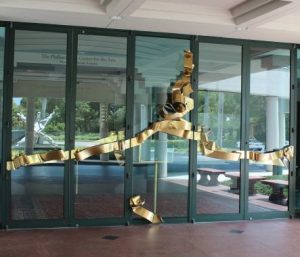 For more information on the other artworks located throughout Fort Myers, please visit culturenow.org, the Public Art Archive and FortMyersPublicArt.com or pick up a copy of The City of Fort Myers Public Art Collection brochure at City Hall. For more on Naiad, read here, or wait until the app goes live.
For more information on the other artworks located throughout Fort Myers, please visit culturenow.org, the Public Art Archive and FortMyersPublicArt.com or pick up a copy of The City of Fort Myers Public Art Collection brochure at City Hall. For more on Naiad, read here, or wait until the app goes live.
June 7, 2018.
RELATED POSTS.














 Tom Hall is both an amateur artist and aspiring novelist who writes art quest thrillers. He is in the final stages of completing his debut novel titled "Art Detective," a story that fictionalizes the discovery of the fabled billion-dollar Impressionist collection of Parisian art dealer Josse Bernheim-Jeune, thought by many to have perished during World War II when the collection's hiding place, Castle de Rastignac in southern France, was destroyed by the Wehrmacht in reprisal for attacks made by members of the Resistance operating in the area. A former tax attorney, Tom holds a bachelor's degree as well as both a juris doctorate and masters of laws in taxation from the University of Florida. Tom lives in Estero, Florida with his fiancee, Connie, and their four cats.
Tom Hall is both an amateur artist and aspiring novelist who writes art quest thrillers. He is in the final stages of completing his debut novel titled "Art Detective," a story that fictionalizes the discovery of the fabled billion-dollar Impressionist collection of Parisian art dealer Josse Bernheim-Jeune, thought by many to have perished during World War II when the collection's hiding place, Castle de Rastignac in southern France, was destroyed by the Wehrmacht in reprisal for attacks made by members of the Resistance operating in the area. A former tax attorney, Tom holds a bachelor's degree as well as both a juris doctorate and masters of laws in taxation from the University of Florida. Tom lives in Estero, Florida with his fiancee, Connie, and their four cats.